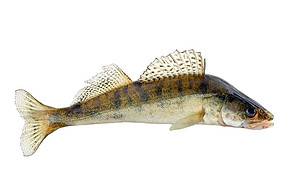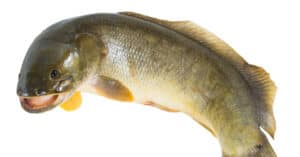Bowfin vs. Snakehead
The bowfin and snakehead are both predatory freshwater fish that look superficially similar to each other because of their long bodies and big dorsal fins. People in the eastern United States often mistake them for each other because they happen to overlap here. However, when we compare the bowfin vs snakehead, whereas the bowfin is a native of North America, the snakehead is actually an invasive species originating from Asia and Africa.
Despite their superficially similar appearance, they’re not closely related at all. From an evolutionary perspective, they are actually quite distinct. This is reflected in their taxonomical classifications. The bowfin is a member of the order Amiiformes (and the only living species within it). It is actually more closely related to the gars, a long, freshwater, or brackish order of fish native to North America. The snakeheads (which include around 25 species in total) are members of the order Anabantiformes. They are more closely related to a group of fish called the gourami; these are round-bodied Asian fish with the ability to partially breathe the air because they swim in oxygen-poor waters.
This article will cover the main differences between the bowfin and the snakehead. While they are not closely related at all, the differences and similarities between them are interesting and instructive. For example, both types of fish can breathe air to cope with low-oxygen environments, albeit in different ways. Their bodies also differ in a few key aspects. This is especially useful information to know if you want to catch or study these freshwater fish.
Comparing Bowfins vs. Snakeheads
Here is a quick breakdown of the key differences between the bowfin and the snakehead.
| Bowfin | Snakehead | |
|---|---|---|
| Size | 20 to 43 inches (50 to 109 cm) | 5 to 40 inches (13 to 101 cm) |
| Distribution | Eastern United States | Africa and Asia (also introduced into the United States) |
| Habitat | Slow-moving rivers, lakes, swamps, and brackish water | Rivers and lakes; can also briefly migrate over land |
| Number of Species | Just one | Around 25 |
| Body Shape | Long body with short anal fin and an eyespot | Long body with large anal fin and no eyespot |
The 5 Key Differences between Bowfins and Snakeheads
1. Bowfin vs Snakehead: Location
The bowfin is native to the eastern United States, while the snakehead is native to Asia and less commonly Africa. Their range does not overlap at all except where the snakehead was intentionally introduced into the eastern United States and became an invasive species.
While Bowfin is edible, it is not considered a desirable fish for eating as it has poor flavor. On the other hand, Snakehead fish are not only edible, but are excellent for eating. If you catch a snakehead, it is encouraged to keep it for dinner as it is very tasty and should not be released back into the wild.
2.Bowfin vs Snakehead: Eyespot
The male or juvenile bowfin (and rarely the adult female bowfin) has a black eyespot surrounded by an orange or yellow border near the back tail, which resembles an eye. This eyespot is intended to confuse or distract predators, so the fish can make a quick escape. While some species of snakeheads also have an eyespot (or even two eyespots) somewhere on their bodies, this is not the case for the northern snakehead, the most common invasive species in the United States.
3.Bowfin vs Snakehead: Anal Fin
As the name suggests, the anal fin is located on the bottom of the fish, near the anus and stomach. It helps to provide the fish with some stability while swimming. The bowfin has a relatively short anal fin, while the snakehead has a much longer anal fin – nearly half the length of the entire body.
4.Bowfin vs Snakehead: Pelvic Fin
The pelvis fin is also located on the bottom of the fish, just in front of the anal fin. For the bowfin, it’s located exactly in the center of the body. But in the snakehead, it’s located much closer to the head. It’s probably shifted forward to accommodate the full length of the anal fin.
5.Bowfin vs Snakehead: Composition of the Head
While it may not be evidence at a quick glance, the bowfin has a bony plate between the lower jawbones. The snakehead completely lacks this feature. Instead, it has large scales on the head. The name of the fish kind of gives it away. Whereas the snakehead resembles a snake, the bowfin’s head resembles a more traditional fish.
Up Next…
- The 5 Best Fish to Catch in Louisiana This Summer
- The Best 6 Fish to Catch in Nebraska This Summer
- Blanket Octopus vs Anglerfish: What’s the difference?
The photo featured at the top of this post is ©
FAQs (Frequently Asked Questions)
What's the difference between a bowfin vs snakehead?
Both types of fish are commonly mistaken for each other in the United States because of their similar body shapes. Fortunately, the bowfin can be distinguished from the snakehead by the shorter anal fin, a pelvic fin at the middle of the body, a black eyespot near the back of the tail (at least in the male or juvenile), and a bony plate rather than scales on the head. It’s also native to slow-moving or brackish waters in the eastern United States and parts of Canada. The snakehead is native to Asia and parts of Africa; a few species have been introduced into American waters, where it has caused some havoc with native species by outcompeting them for resources. The northern snakehead has become permanently established in the Potomac River. It has also been sighted in Hawaii, California, Virginia, Rhode Island, and other states. This has caused many Americans to mistaken them for each other. But it’s actually a total coincidence that they happen to look similar at all.
Are the snakeheads and bowfins closely related?
No, they’re not closely related at all. They are actually separated by more than 100 million years of evolution. In other words, they last shared a common ancestor back when the dinosaurs walked the planet. This is reflected in their taxonomical classification. They don’t even belong to the same orders: the bowfin is a member of the order Amiiformes, whereas the snakehead belongs to the order of Anabantiformes.
Thank you for reading! Have some feedback for us? Contact the AZ Animals editorial team.






